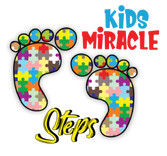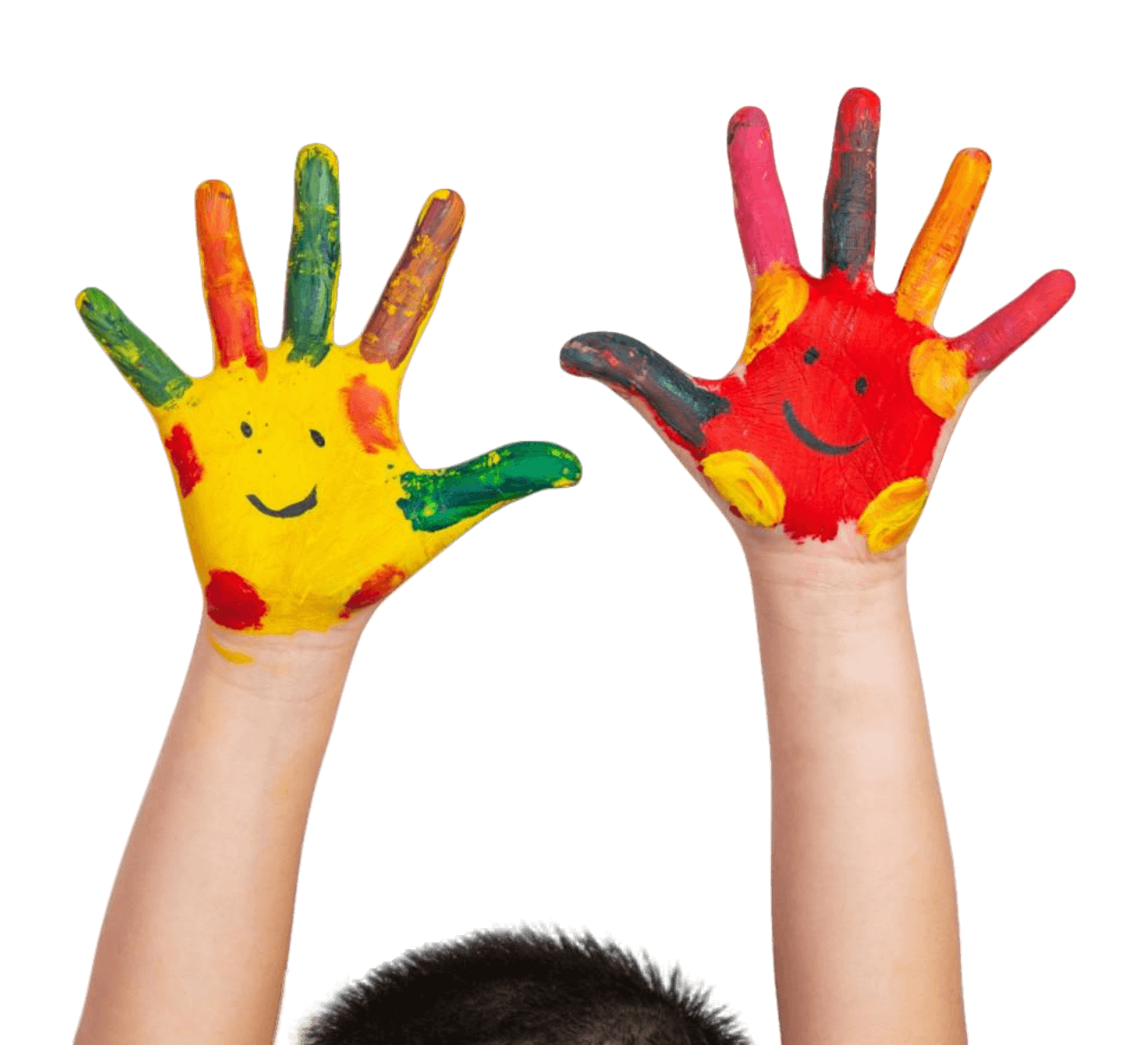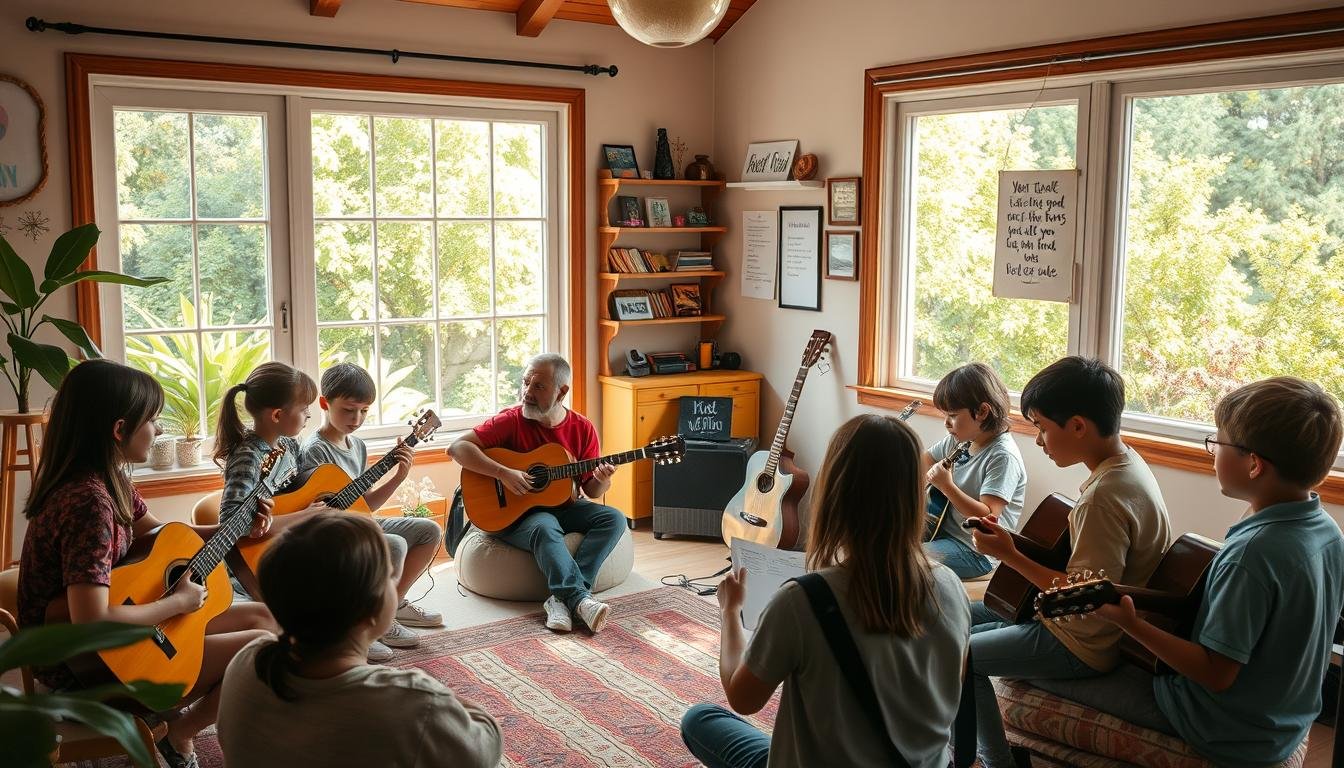Music often speaks when words cannot, especially for children facing trauma. The therapeutic power of songwriting shines in music therapy for kids. Here, melodies and lyrics help children process trauma and express deep feelings. Songwriting becomes a powerful way to heal, giving a voice to those often left unheard.
Imagine a place where kids turn their hurt into songs of strength. Music therapy is that place. It offers a caring way to deal with tough feelings and experiences. Through creating their own music, kids start healing. They move towards feeling strong and in control again.
Songwriting finds a unique spot at the crossroads of healing through music and psychological science. It provides a rich experience for kids who need special support. In this type of therapy, every note and word helps tell a child’s story. This story can bring comfort and also push for growth. Creating music to handle trauma is a flexible and powerful way to heal.
The Power of Music Therapy in Trauma Recovery
Music therapy is a powerful tool for healing. It combines therapy and music to help children who’ve faced trauma. Kids find many benefits through music therapy, from understanding their feelings without talking to controlling their emotions better.
Trauma narrative songwriting is a special part of music therapy. It lets kids share their feelings through song. Making and sharing their trauma stories in music helps them heal deeply. It also builds their strength to deal better with their feelings.
This method helps kids feel in control again and manage their emotions in a good way. By using music in healing, kids learn to turn tough experiences into something they can express. This supports their journey in controlling emotions and gives them power through their own stories.
Music therapy is also great for kids who find it hard to talk about their trauma. It lets them work through their feelings without words. By being involved in music therapy, they make great progress in feeling better mentally and emotionally.
Thus, music therapy’s impact is a mix of proven techniques and caring use of music to help children heal from trauma. It creates a space for them to recover and grow.
Understanding Trauma in Children and Adolescents
Understanding how trauma affects kids calls for a kind and thoughtful look. We must consider their personal experiences and the wider, systemic issues. It shows up in many ways and might confuse those trying to diagnose it. So, integrating thorough and precise stories of diagnosis is key to tackle the mix of things influencing each kid.
When we study trauma’s impact, we see how kids see and process what happens to them. They often soak up the traumas from around them, like at school or in the community. This can really shape how they grow emotionally and mentally.
Handling these stories when diagnosing is very important. Kids aren’t just taking in these diagnoses; they interact with them. This interaction can totally change how they view themselves and their journey to getting better. Making sure these diagnoses help rather than hurt requires careful attention and the ability to change methods as we learn more about what each child needs.
Dealing with trauma and its many forms needs a careful diagnosing process. Just using a checklist of symptoms might not be enough. We need a detailed method that can tell the difference between trauma-related symptoms and others. This way, we can create a more specific and effective plan for getting better.
Creating a setting where we thoughtfully build and often review diagnostic stories helps avoid wrong diagnoses. It also lays the groundwork for healthier growth. Music therapy shows a lot of promise. It provides a way to express and work through feelings without words. We’ll dive more into this in future talks.
Songwriting as a Therapeutic Tool
Trauma deeply affects kids and teens, and sharing their feelings can be tough. The therapeutic songwriting process isn’t just about making music. It’s a way to share emotions that builds empowerment, offering a secure place for their stories to be heard.
Using stories in songwriting helps kids create their own tales. This promotes narrative integration, which is healing and helpful. The process includes steps from brainstorming to performing, solidifying the therapy benefits of songwriting.

Songwriting leads kids to express their inner conflicts and achievements, often sparking therapy breakthroughs. It helps them understand their past and fosters a brighter future. Empowerment through songwriting is a true experience, grown from creativity and insight.
Let’s look at how this method works in therapy and its advantages:
| Step | Activity | Benefit |
|---|---|---|
| 1. Brainstorming | Discussing themes and personal stories | Initiates emotional expression and connection |
| 2. Writing Lyrics | Turning thoughts into words | Fosters narrative integration |
| 3. Composing Music | Adding melodies to lyrics | Builds a bond with their expression |
| 4. Rehearsal & Performance | Practicing and showing their song | Boosts confidence and supports healing |
Every step in the songwriting journey helps kids heal and grow after trauma. It lets them share their stories through music, leading to boosts in confidence, resilience, and understanding. Songwriting isn’t just therapy; it’s a way for them to find their voice and strength.
Case Studies: Success Stories in Music Therapy
Music therapy has a powerful impact, especially for kids getting over trauma. Enlightening case studies show its success. For instance, kids writing songs in workshops saw big boosts in handling their emotions better. This skill is key for those shaken by tough experiences.
These stories highlight how kids express themselves more after songwriting. This lets them share their feelings in a unique way, helping them heal. When they share, it makes others around them—like friends and family—understand and care more.
Music therapy also gives kids a chance to freely explore their feelings. This process might help them remember happy times and improve their self-view. Both the kids and their whole community benefit from music therapy. It aids their healing and strengthens support around them.
These case studies prove music therapy, through songwriting, brings back control and happiness to kids’ lives. They start to recover from past trauma successfully. This therapy proves to be a key tool in making kids who have faced a lot feel better again.
Implementing Music Therapy Programs in Schools and Communities
Exploring the growth of music therapy implementation in schools and community settings is essential. It’s vital to set up programs that are based on research and customized to help kids facing trauma. By combining school-based programs and community support, we can improve access and the effects of these therapies.
Starting successfully often means training facilitators with a focus on trauma-sensitive methods. These methods make sure the space is safe and welcoming for everyone to express themselves. Effective strategies for strong music therapy programs include:
- Building relationships with school leaders to integrate music therapy into the curriculum, making it a regular educational feature.
- Getting support from the local community to find places for therapy sessions, performances, and music events that heal and empower.
- Adjusting therapy activities to match the cultural and personal backgrounds of the participants, making sessions more relevant and engaging.
- Trying out small-scale projects to perfect therapy approaches before bringing them to more people.
When educators, therapists, and community leaders work together, music therapy implementation can become a key part of both education and community services. The engagement and support of everyone in the community help to create a caring space where healing through music can thrive. This makes a real difference in the lives of children who need it the most.
Choosing the Right Music Therapist
Searching for a certified music therapist for a child with special needs is crucial. It’s important to find a professional with the right certifications and deep experience with trauma cases. They should know how to create a strong therapeutic relationship and design a therapy plan suited just for your child’s needs.

A certified music therapist who follows evidence-based practice blends musical skills with therapy techniques. This approach makes the therapy more effective. It gives your child the best support for healing from trauma.
- Find a therapist who is certified and has training in dealing with trauma.
- Make sure the therapist uses evidence-based practices. These practices have been proven to help with recovery.
- A good therapeutic relationship is vital. Choose a therapist who makes your child feel safe. This will help their healing.
Finding the right music therapist means picking someone who can deeply connect with your child. They should tailor the therapy to meet your child’s specific needs. This ensures a better emotional and psychological future for them.
Help Children Process Trauma Through Creative Expression
Helping children with special needs often involves creative activities. These include art and music, which do more than fill time. They’re key in helping kids process trauma. Kids learn that they don’t only have to use words to share what they feel.
Using art or music lets children express hard-to-say feelings. When talking is tough, painting or making music can be a big help. This way, kids can show their feelings and start to heal from their trauma.
Adding these activities to therapy makes it more helpful. For example, art therapy reduces anxiety and PTSD symptoms in kids. This shows how creating can help heal.
Creative expression gives children a way to tell their own stories. They gain control and a better understanding of their feelings. It’s crucial for adults to create a safe space for this creative sharing. This helps kids in their healing journey.
Parental and Caregiver Support in Music Therapy
Caregiver involvement is key in music therapy for kids recovering from trauma. When parents and caregivers join in, they boost the therapy’s goals. They also give the emotional support kids need during tough times.
It’s vital for caregivers to grasp their part in therapy. They should be part of sessions, use therapy ideas at home, and make a supportive space. This helps kids express themselves and heal emotionally.
| Activity | Benefits | Role of Caregiver |
|---|---|---|
| Educational Workshops | Provides knowledge on how music therapy aids trauma recovery | Understanding the therapy process to better support the child |
| Participation in Sessions | Reinforces treatment techniques and therapeutic goals | Engaging directly with the child and therapist |
| Creating Musical Moments at Home | Encourages continued emotional expression and processing | Fostering a nurturing home environment that complements the therapy |
You want the best for your child, and being involved in their music therapy helps. Being part of their recovery journey is key. By working together, we create a strong support circle. This circle boosts caregiver involvement, emotional support, and active therapy participation.
Conclusion
Songwriting can change kids’ lives, especially those who’ve faced tough times. Music therapy lets them share their feelings safely. It’s more than just music. It’s about their path to getting better and growing stronger.
In every song, kids find ways to learn about themselves. Understanding trauma helps us make therapy that really connects with them. Together with music therapists, we create a place where kids feel truly listened to. Music brings us together and gives kids strength.
We’re not stopping our work here. Look for local music help and see how it can benefit kids around you. Kids Miracle Steps is ready to help you with this musical adventure. Let’s make sure every child’s voice adds to a harmony of healing and hope.






